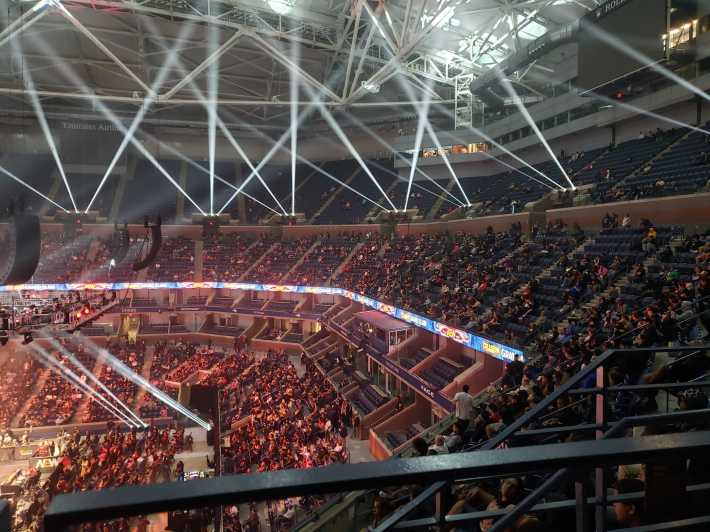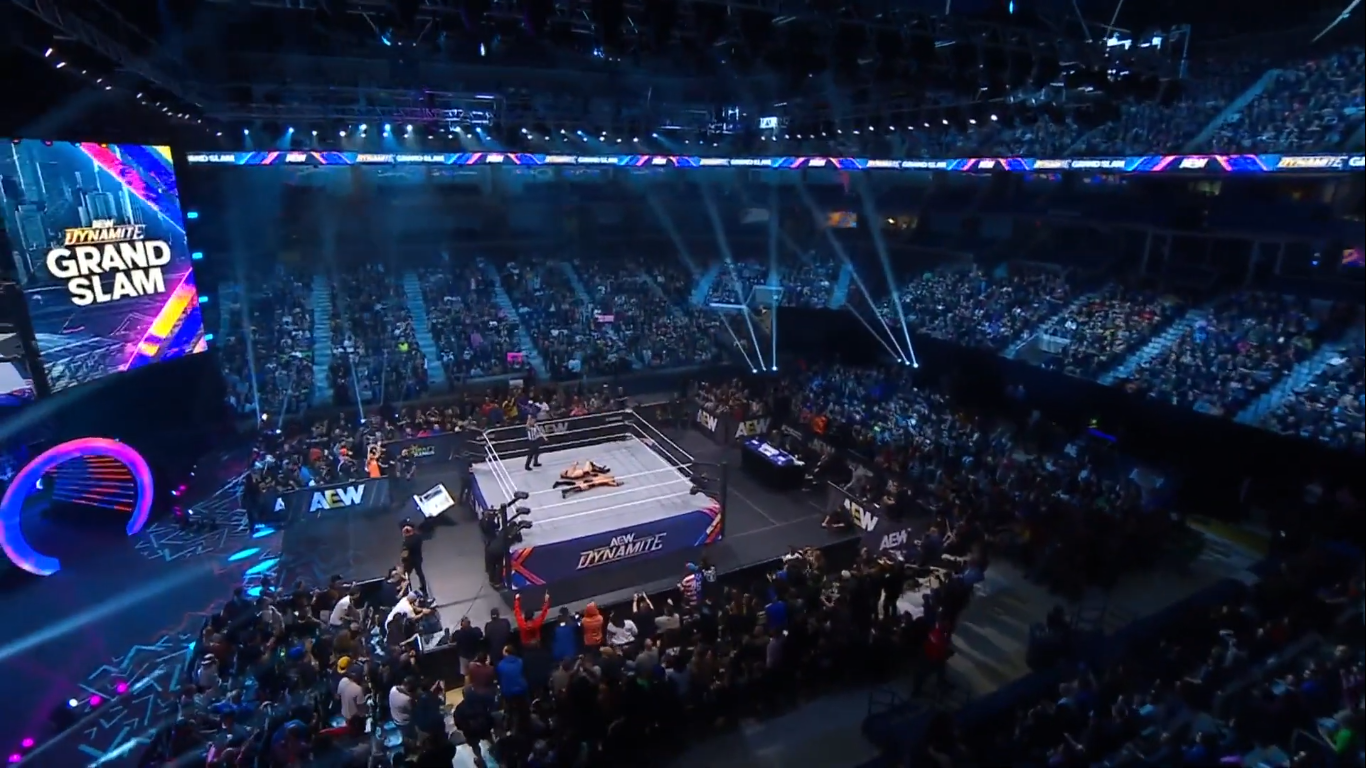QUEENS, N.Y. — The final stretch of All Elite Wrestling's annual September blowout at Arthur Ashe Stadium, Grand Slam, feels remarkably similar to the back half of the nighttime tennis doubleheaders that run at these grounds for the U.S. Open a few weeks earlier. Like the Open, there is a primetime segment that captures the audience at peak capacity—for AEW, that's the live airing of their show Dynamite from 8 to 10 p.m. But also like the U.S. Open, there is a lot left for those who stick around late into the night—a whole other tennis match, or, in AEW's case, a taping for one of their other TV obligations that stretches past midnight.
As such, when I leave Arthur Ashe, the atmosphere is different than the feeling leaving any other sports arena I've ever entered. The crowd is no longer a cohesive throng high on a win, crushed by a loss, or simply juiced from the action. It's more a collection of individuals thinking, We were the ones who cared enough to stick it out, and Oh god, when am I going to get to sleep?
I've been to three of the four AEW Grand Slams, missing only last year's. I had a good time on Wednesday and certainly got a lot of wrestling for my money. However, if this show is a bellwether for the overall health of the now 5-year-old AEW, the prognosis for the promotion remains unsettled. In the excitement of September 2021, it felt like a once-in-a-lifetime event—a debut for the company in this market after two years of pent-up demand, and a packed house of over 20,000 that poured all of its enthusiasm into the ring. A year later, the crowd was 14,000—still plenty to provide a big-time feel. In 2023, a late media blitz helped get them to 11,000—a fine number. In 2024, the attendance was reportedly 8,000, and much smaller by the end.
It made for a lacking visual and aural experience. The stage, once unique to this event, was instead the smaller one recycled from regular TV, and the company didn't bring their own giant screen this time to place above the ring for the cheap seats to see the action. A huge chunk of the arena was sectioned off by a big black curtain. While the loudest and best moments of the show were deafening, there were also stretches of eerie quiet both before the warm-up started and toward the end—almost like those in attendance were trespassing on a much more private affair.

From this and other signs, it's clear not only that the competition, a red-hot WWE, is denting AEW's popularity, but also that there's a burnout from these shows, and so many others tasked with filling the expanding content hole. Add this to the fact that AEW President Tony Khan is absolutely terrible about advertising in advance who is going to be at his events, throw in the long-term impact of his momentum-killing, everybody-gets-a-turn anthology-show booking style, and it's hard to argue that the crowd at Ashe should be any bigger than it was.
I'm really not trying to be the girl obsessed with crowd size, but when you're watching a tradition you care about dissolve into unviability before your eyes, it's hard not to have some concerns. Nevertheless, across these five hours, there were plenty of moments that reinforced my appreciation for the highs of AEW, even as I've never been less satisfied by its broader output. In chronological order:
- Before the live portion, two unadvertised Japanese legends shared a ring: Katsuyori Shibata and Minoru Suzuki. I adore Shibata, and I love what Suzuki is doing with his career right now, and the sheer randomness of suddenly being confronted with both, together, in a gigantic arena in Flushing, Queens, of all places, fed my inner geek.
- Indie legend Nigel McGuinness opened Dynamite by wrestling essentially his first match in 13 years, reigniting a cult-favorite rivalry with world champion Bryan Danielson. He looked really good, and his presence in particular helped elevate this Grand Slam in my eyes from strong show to must-see event.
- What more can I say about Danielson? This might have been the last time I'll see him wrestle live, and of course he made it worthwhile. Entering and exiting to "The Final Countdown," which allowed the audience to scream along to the chorus multiple times, he delivered another showcase of impeccable control and everyman physicality, and he made sure to take a victory lap for the crowd. If the last image I have of his career is him standing on a table, facing outward, absorbing the gratitude in the form of Europe karaoke, that's cool.
- Tag team champs the Young Bucks, pioneers of the kinetic multi-man sprint that's become AEW's calling card, broke out of an in-ring slump with a match against Will Ospreay and Kyle Fletcher that stretched the lungs of the crowd with displays of maximalist action. I found myself biting on false finishes, and that's always a fun feeling as a fan.
- The Dynamite main event, Jon Moxley vs. Darby Allin, was unconventional for the way it was just Allin absorbing more and more punishment without ever making a comeback. The crowd, near the end, was chanting "You can't kill him!" so this was basically the climax of Raging Bull. A skinny little skateboarding daredevil at heart, Allin has a sense for how to make his bumps look as punishing as possible, and him just letting Moxley fling him around made a deep impression.
- There was a "lumberjack strap match" in the taped portion. It was different than I imagined it would be.
- Kazuchika Okada closed the show for the hardcores that stayed. Two years ago, when he was still under contract as the franchise player in New Japan Pro Wrestling, I bought a ticket specifically to go see him with about 1,000 other Japanese wrestling fans at an underground venue in Midtown Manhattan, so I looked forward to the contrast of the bright lights at Ashe. As a full-time American now, Okada is having some fun and taking it easier, not carrying his employer on his back like he did back home. Given the lateness of the hour, it was almost like he was trolling the crowd with the way he slowed the pace, but it only made him seem more regal to me. That AEW still had an Okada match left to give after such a parade of names only emphasized how loaded the roster is.
As I see it, there are two things about AEW that explain almost everything it does, for better or worse: 1) Khan is a gigantic wrestling nerd, and 2) he can't really conceive of people not liking what he thinks is awesome. The man's appetite for just putting two guys (almost always guys) he likes in the ring and letting them run free, without necessarily any regard for story discipline or future planning, is bottomless. But a half-decade in, as AEW has increased its weekly TV obligations from two hours to five, it's starting to run up against the limits of that philosophy.
When AEW debuted, it was like nothing else in the U.S. mainstream, and despite WWE's commercial superiority it still boasts matches that move faster and hit more viscerally than the larger, more sponsor-friendly company. In-ring proficiency should still be AEW's bread and butter, but after five years of excellent performances they've raised the bar so high that they can no longer consistently meet it. Earlier this year, there was a kind of goofy rallying cry around AEW: "Restore the feeling!" i.e. Make this company feel like upstart rebels again. Recent signing Will Ospreay embodies this attempt at a resurgence, and has been embraced by the fans because he can do impossibly athletic tricks seemingly at will and tries to steal the show every time he steps into the ring. Ospreay is essentially the endpoint in the evolution of "best wrestler" from "guy who kicks the most ass in storyline" to "guy who participates in the longest matches." I think he's very entertaining, because there's real joy in seeing a guy fly through the air, and then fly through the air again while you're still reacting to the first flight. I also believe in "the feeling" as a real concept—that thing in wrestling fandom where your excitement blurs the line between performance and reality, where you're mad about cheating or pacing around your living room or just genuinely hoping a performer/character can pick up a big win. But I don't think it correlates at all to a match's length or danger.
Basically, I like when I can imagine what a wrestler does on their day off—that is, when I'm invested in their character enough that they stay tangible even when the cameras aren't on. I'm thinking of "Hangman" Adam Page's chase for the AEW title, or Danielson's current fight against his body to prolong his career. These are journeys you share not just through "Oh my god" moments, but through a promoter's consistent faith in their talent. More and more while watching AEW episodes, I'm seeing a bunch of familiarly plotted matches and asking myself questions like: What's the significance of this belt supposed to be? What did this person accomplish to earn a main-event slot? Whatever happened to that guy who just disappeared from TV a month ago? There seems to be less and less interest in answering those questions, and as a result I have less and less interest in even asking them.
All this being said, and for all there is left to say about AEW's decline, the company seems poised to announce perhaps the best news in its history. Reportedly, it's about to sign a big new TV deal with its Warner/Turner/whatever-the-hell-it-is-now overlords, which would reward its success over the past five years and make it financially stable for the next several. This is uncharted territory: There's never been a period this long in the States where two national wrestling companies have enjoyed this level of sustained interest and competition. But here is the extent to which it's relevant to me: It means sometime around September 2027, there will probably be a show near my home where a bunch of sick, sexy men perform all genres of wrestling match in a large venue until everybody's exhausted. I'll probably still want to go.






